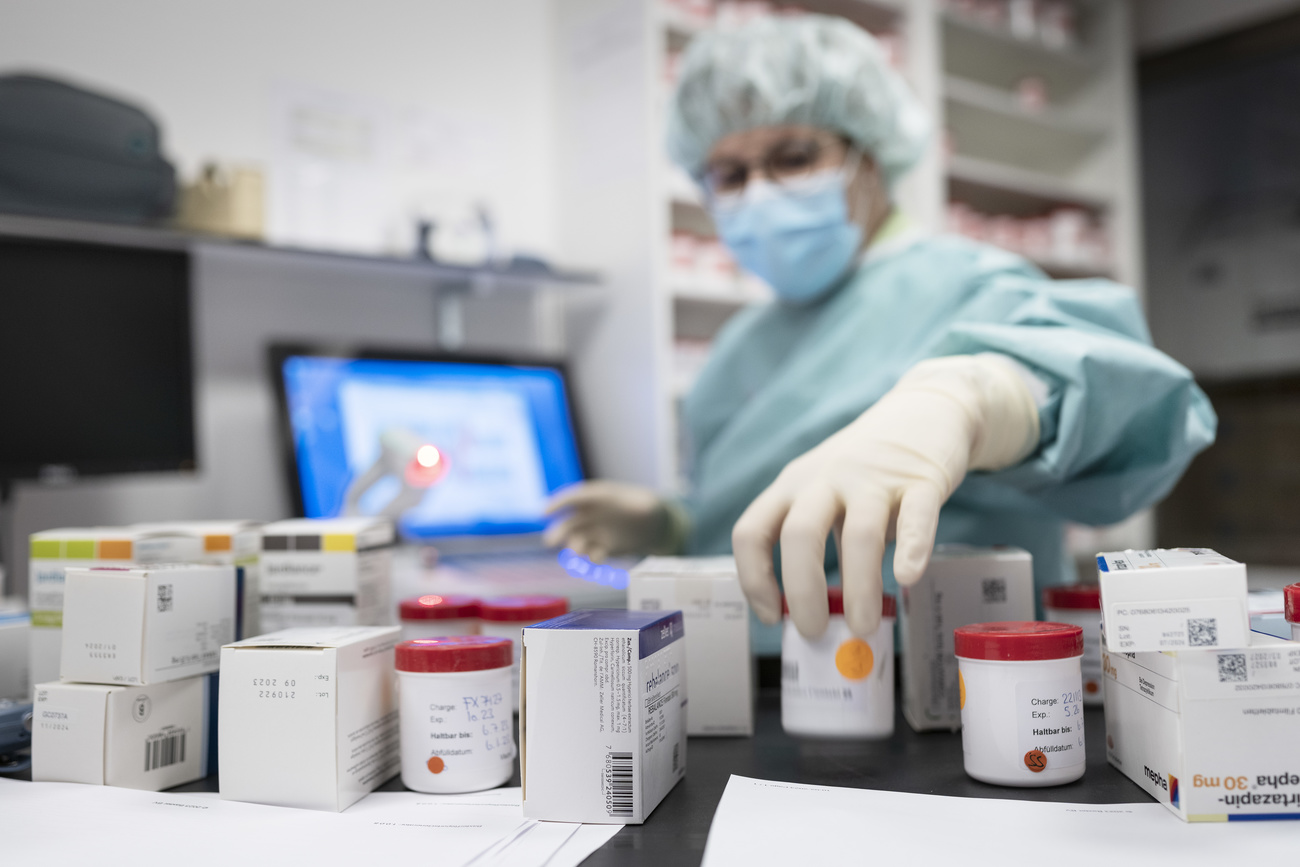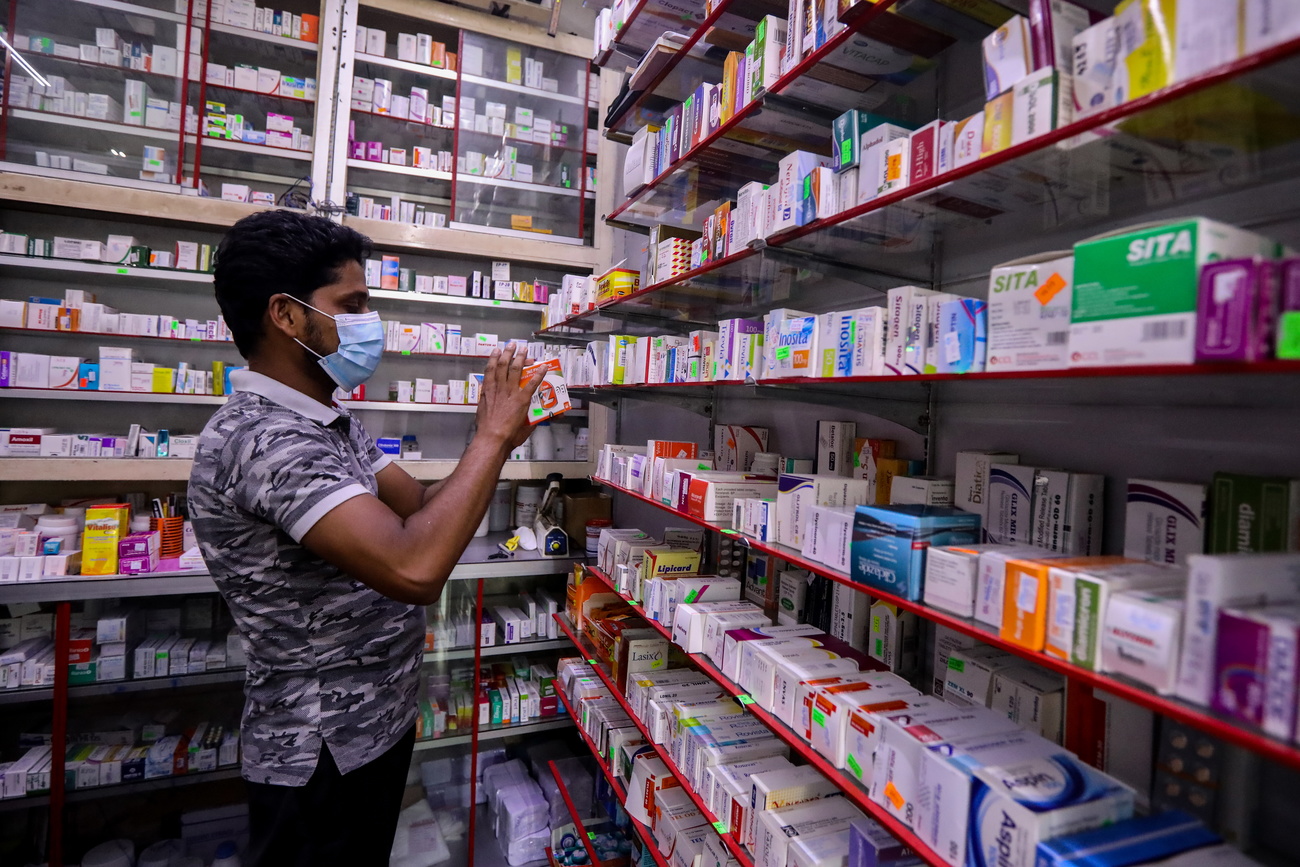
Swiss inaction threatens global antibiotic development push

Switzerland is a major hub for pharmaceutical companies, but it has done little to encourage the development of new antibiotics – a shortfall that could have serious consequences at home and abroad.
Global health experts have long warned that resistance to antimicrobials, including antibiotics, is a slow-moving crisis with deadly consequences. In 2019, antimicrobial resistance (AMR) caused an estimated 1.3 million deaths globally – the third leading cause of death that year, according to the Lancet. According to one estimate, by 2050, AMR could claim up to 10 million lives annually – on par with cancer.
Despite these warnings, few companies are developing new antibiotics based on a basic calculation: antibiotics are expensive to develop but generate little profit. A new drug can take 10–15 years and over $1 billion (CHF790 million) to develop, but antibiotics are expected to be cheap and used sparingly to prevent resistance.
This economic mismatch has led public health experts to call for new purchasing models. One option is paying companies an annual subscription fee for access to an antibiotic – rather than paying per pill – to guarantee returns regardless of usage. A handful of countries, including the UK, Sweden, and Japan, are piloting such “pull” incentive schemes. But Switzerland’s progress has been slow. If plans stay on track, incentives won’t arrive until 2029.
“If a wealthy country like Switzerland doesn’t join international efforts to create reimbursement models for new antibiotics, this will not send an encouraging signal to other countries and investors,” said Barbara Polek, managing director of the Swiss Round Table on Antibiotics.
“There’s a risk that new antibiotics won’t be ready in time to replace resistance-struck antibiotics, and researchers will leave the field entirely.”
A class of antibiotics is a group with similar chemical structures and mechanisms. Members of a class often work by targeting the same bacterial process and may have similar resistance patterns. Experts count around 13 antibiotic classes.
Mounting supply issues
For doctors like Silvio Brugger at University Hospital Zurich (USZ), the risk of running out of effective antibiotics isn’t a far-off hypothetical. Although antimicrobial resistance is relatively low in Switzerland, there are growing concerns as patients come from abroad with drug-resistant strains.
Last year, Brugger treated a 44-year-old burn victim with Carbapenem-resistant Acinetobacter baumannii (CRAB), a drug-resistant bacterium that can cause severe infections. “The level of resistance was scary,” Brugger said. “The bacteria were colonising everywhere – in the nose, lungs, and wounds, and subsequently transitioned to the blood. Without treatment, such patients have a very high risk of dying due to the infection.”
CRAB spreads easily in hospitals, especially in humid environments like burn units. In 2007, a CRAB outbreakExternal link forced a burn unit in western Switzerland to temporarily shut down for decontamination.
Only one antibiotic – Sulbactam-durlobactam (brand name: Xacduro) – was effective against CRAB. Approved by US regulators in 2023, it’s not yet licensed in Switzerland and must be imported on a case-by-case basis. USZ imported it at a premium, saving the patient’s life.
Brugger worries that such scenarios are becoming the norm. “More and more antibiotics needed for treating patients aren’t licensed here and must be imported,” he said.
With low expected sales, especially in a small market of nine million people, some companies decide to delay or forego commercialisation. Some don’t even submit an approval application to the Swiss medicines regulator.

More
Why Switzerland is running out of pharmaceuticals
A studyExternal link of 18 new antibiotics approved in major markets from 2010–2020 found that only six were launched in Switzerland – putting it on par with countries like Romania and Greece.
Meanwhile, older antibiotics are also harder to access. Between 2023 and 2025, Geneva University Hospitals (HUG) reported 88 antibiotic stockouts affecting 32 substances, according to hospital pharmacist Yassine Dhif. In 16 cases, HUG had to import medicines; in five, the drug wasn’t available at all in Switzerland due to lack of authorisation or market withdrawal.
This comes with a cost. On average, imported antibiotics are 2.5 times more expensive, with some costing up to five times the normal price, according to Dhif. Importing also delays treatment and increases hospital liability.
A broken market
The growing demand for imported antibiotics is a symptom of a much larger problem.
Antibiotics are essential medicines that should be affordable to the masses according to the World Health Organization (WHO). Yet, in contrast to generic drugs, developing a new class of antibiotics is extremely costly.
“Antibiotics, no matter how innovative, are expected to be as cheap as chips,” said Mark Jones, head of global affairs at Swiss biotech Basilea, which developed the antibiotic Zevtera. “And unlike cancer drugs, the best new antibiotics are kept as a last resort, locked behind a cupboard door.”
This makes it nearly impossible for developers – often small, underfunded firms – to cover costs. Most big pharmaceutical companies, who typically acquire promising drug candidates, left the antibiotics field.
So-called “push incentives” in the form of grants and subsidies have helped some firms cover early research and clinical trial costs. Experts warn though that without sustained financial incentives, these drugs won’t be available when we need them.
US-based company Achaogon, founded in 2002, received US approval for its antibiotic Zemdri (plazomicin) in 2018 but still failed to cover the costs of launching the product, filing for bankruptcy shortly after.
“This is a global problem. High-income countries like Switzerland really need to step up and provide the right market incentives, so there’s enough return on investment to have companies, small and big, continue developing antibiotics,” said Henry Skinner, CEO of the AMR Action Fund, aims to invest $1 billion in clinical-stage biotech companies. “If selling antibiotics loses money, no one will invest.”

More
Looming bacterial pandemic triggers debate over how to pay for new antibiotics
Some countries are testing incentive models. In 2019, the UK started piloting a Netflix-style subscription scheme where the National Health Service (NHS) pays a fixed annual fee for access to antibiotics, regardless of how much is used. ItExternal link became a formal procurement policy in May 2024 after it improvedExternal link cash flow for companies and access for patients. Japan, Sweden, Italy, and Canada are also testing incentives.
Waiting game
But progress in Switzerland has been slow. The government has been talking about incentives for new antibiotics for at least a decade as part of its national AMR strategy.External link
Doctors who spoke to Swissinfo said they struggle to communicate urgency in Switzerland, which has relatively low rates of AMR, strong public health campaigns on appropriate use of antibiotics, and can afford to import antibiotics as needed.
“Switzerland has the advantage of being wealthy,” said Stephan Harbarth, division chief in infection control at HUG. “In most countries, a doctor can’t just ask their pharmacist to import a new drug regardless of the cost.”
But this may not be the case forever if companies can’t afford to develop drugs.
“It’s not just about access to antibiotics for our patients here,” he said. “Switzerland, with its wealth and pharmaceutical industry, has a responsibility to ensure the world doesn’t run out of antibiotics.”
Swiss companies, Basilea, Bioversys and Roche, all benefit from funding and incentives provided by other countries.
The Swiss government has pushed backExternal link on previous parliamentary proposals for pull incentives, citing costs and other actions it is taking to combat resistance. In response to a Swissinfo inquiry, the Swiss public health office said the government plans to submit a proposal to parliament in autumn 2025 to revise the Epidemics Act, which would provide a legal basis to introduce financial incentives for antibiotics. The earliest this could take effect is 2029.
But the clock is ticking. In May, Swiss drugmaker Roche – one of the few major companies still researching antibiotics – announced it was moving a new antibiotic, zosurabalpin, into late-stage clinical trials. It would be the first new class in 50 years capable of killing Gram-negative bacteria, which are especially resistant due to their double membrane.
Michael Oberreiter, head of global access at Roche, said the company is willing to take some risks to ensure access – but that incentives from wealthy countries are needed to sustain innovation.
“Without this, companies will leave or simply not enter the market in the first place, and exacerbate the ‘brain-drain’ we see in the field already, where researchers move into other areas,” said Oberreiter. “This would take many years to reverse.”
Edited by Virginie Mangin/sb

In compliance with the JTI standards
More: SWI swissinfo.ch certified by the Journalism Trust Initiative
































You can find an overview of ongoing debates with our journalists here . Please join us!
If you want to start a conversation about a topic raised in this article or want to report factual errors, email us at english@swissinfo.ch.